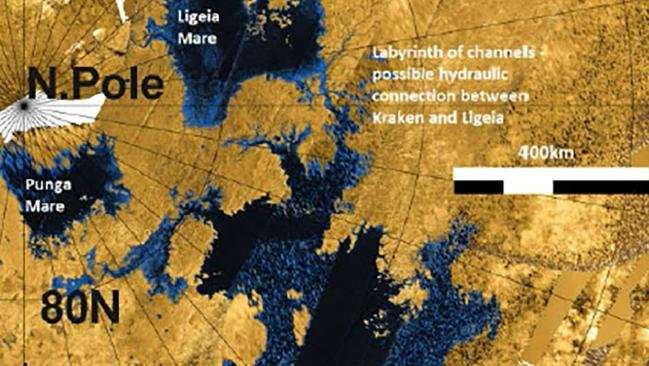The Cassini Huygens spacecraft has spent over a decade studying Saturn for NASA and the European Space Agency (ESA). It has discovered that its moons Titan and Enceladus have some key conditions for supporting life.
NASA’s Cassini space probe recently discovered what is thought to be the largest body of liquid on Saturn’s Titan moon — and now the space agency wants to go swimming.
In 2008 the 400,000sq km ocean was named Kraken Mare after a legendary sea monster. Not long after, scientists at NASA began dreaming up ways to explore it.
The agency’s idea — as ambitious as it may be — is to send an autonomous submarine.
Titan is the only place in our solar system where we’ve found surface liquids and, as the thinking goes, where there is water, there is probably life.
However it would have to be a pretty resilient life form given that the rivers and lakes on Titan’s surface carry a lethal mixture of methane and ethane.
The proposed submarine being considered by NASA would autonomously carry out detailed scientific investigations under the surface of Titan’s northern ocean, providing unprecedented knowledge of an extraterrestrial sea and expanding NASA’s existing capabilities in planetary exploration to include nautical operations, the space agency says.
Concepts for exploring extraterrestrial oceans have been proposed in the past but they usually centred on more simple ideas like sending down suspended probes.
“As such no one has yet envisioned what such a craft might look like, how it would operate or if it could be built,” NASA’s mission website says.
Nonetheless the space agency has mapped out a conceptual mission design for the Titan Submarine and is considering pursuing the lofty mission within the next 20 years.
It’s 1.4 billion km to Titan, so it would require a pretty serious spacecraft to get the submarine there. But if it does happen, the University of Washington has been helping NASA simulate the condition such a vehicle would encounter upon arrival.
This month the WSU research team announced they had built a test chamber to house a liquid mixture at very cold temperatures to simulate the -184C Kraken sea.
One thing researchers are looking at is bubbles. A submarine powered by a heat-producing machine in the very cold Titan liquid will cause nitrogen bubbles to form and too many bubbles would make it hard to manoeuvre the ship.
The group also studied the freezing temperatures for methane and ethane lakes and determined that, because of a small amount of nitrogen in the liquid, the lakes freeze at lower temperatures than they expected.
“That’s a big deal,’’ said researcher Ian Richardson. “That means you don’t have to worry about icebergs.”
If the mission goes ahead, it will represent a new frontier of space exploration.
“By addressing the challenges of autonomous submersible exploration in a cold outer solar system environment, Titan Sub serves as a pathfinder for even more exotic future exploration of the sub-surface water oceans of (Jupiter’s moon) Europa,” NASA says.

zamach on February 13rd, 2018 at 10:46 UTC »
I can imagine a conversation in NASA going like this:
"Hey, how do we top sending a car to Mars?"
"I don't know. We send submarine to Saturn or something?"
Next time we will be watching Elon launching a literal cruise ship to space, so NASA will have a hard nut to crack how to top THAT.
juttep1 on February 13rd, 2018 at 10:24 UTC »
This is incredible. It's really a win win win.
This mission could possibly find life existing on another planet within our solar system - THE holy grail of space exploration.
Even if that doesn't happen, this truly pushes the boundaries of what man can conceive, build, and implement in space. Leading the way for potentially useful discoveries just in the engineering process alone.
and it also hold the potential to inspire future engineers and space explorers.
what's not to like? You wanna go to the moon of an exo another planet? pssh, we went into the ocean on an exo planetary moon. It even fits the bravado of America.
I'm 100% excited and hope this actually happens within my lifetime.
Edit: Saturn is not an exo planet
Arcruex on February 13rd, 2018 at 09:42 UTC »
"This month the WSU research team announced they had built a test chamber to house a liquid mixture at very cold temperatures to simulate the -184C Kraken sea." So that they can see if the equipment is feasible...
Can life even grow to begin existing in such an environment? They have looked into the reality of this projects aim? Maybe they'll find something interesting regardless.